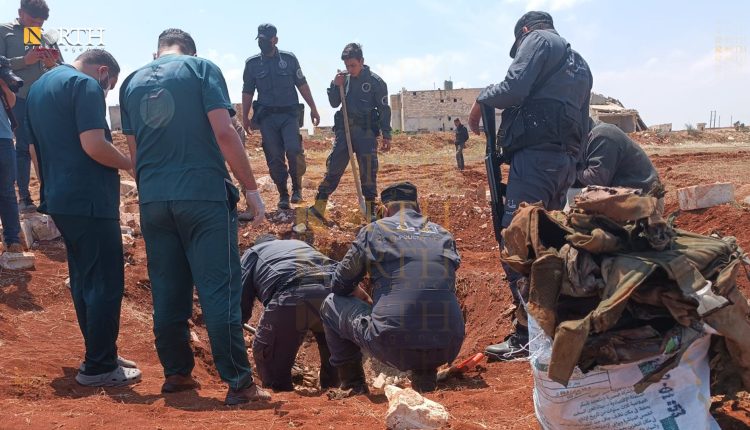Mass Graves Discovered in Northwest Syria Near Saraqib
By Kardo Roj
IDLIB, Syria (North Press) – Forensic teams uncovered three new mass graves on Tuesday near the town of Saraqib in the western countryside of Idlib Governorate, northwest Syria, raising fresh concerns about past atrocities in the war-torn region.
The graves, discovered west of Saraqib, come just days after another mass grave was found nearby containing the remains of eight individuals, believed to have been killed during a previous period of control by Syrian government forces.
Dr. Zaher al-Taqash, a forensic specialist involved in the excavation, told North Press that initial assessments of the first site revealed the remains of three individuals, including a young girl. Work is ongoing to examine the two remaining sites, with further details expected once exhumation and forensic analysis are complete.
According to a government-affiliated source present at the excavation, at least eight mass graves have now been identified in the Saraqib area of rural Idlib. The full extent of the number of victims and the timeline of the killings remains under investigation.
“These findings are part of a disturbing pattern that suggests systematic killings during earlier phases of the conflict,” the source stated, requesting anonymity due to the sensitivity of the investigation.
The area had been under the control of Syrian government forces from 2020 until late last year, when opposition factions and Hayat Tahrir al-Sham (HTS) seized control shortly before the government’s collapse in the region.
While forensic teams have yet to confirm the exact date and cause of death of the victims, preliminary indicators and the location of the graves point to a period during which the area was under state security and military control.
The discovery has reignited calls from human rights groups and local activists for independent investigations into possible war crimes committed over the course of Syria’s protracted conflict.
Local residents and survivors’ groups in northwest Syria, where control has changed hands multiple times, have long voiced concerns about enforced disappearances, extrajudicial killings, and secret detentions, particularly in areas that were formerly under government control.
International human rights organizations, including Human Rights Watch and Amnesty International, have previously documented patterns of arbitrary detention and mass killings throughout Syria, urging that proper documentation and evidence preservation be prioritized for future accountability mechanisms.
The Saraqib area, located at the intersection of key highways (M4 and M5), has strategic importance and has seen intense fighting over the past several years. Control has shifted among various actors including the Syrian government, opposition factions backed by Turkey, and HTS.
Since the late 2024 withdrawal of government forces from key positions in the region, HTS has consolidated administrative control, although security conditions remain volatile and humanitarian access is limited.
The broader Idlib region continues to operate outside the framework of the Autonomous Administration of North and East Syria (AANES), which governs much of Syria’s northeast in coordination with the Syrian Democratic Forces (SDF). While AANES-led areas have invested in documenting human rights violations and transitional justice mechanisms, northwest Syria remains marked by fragmentation and the absence of unified civil administration.
Forensic teams have stressed the importance of securing the mass grave sites and conducting professional exhumation procedures to ensure the integrity of evidence. However, access for independent observers remains a challenge in areas controlled by armed factions with unclear accountability structures.
As Syria moves—albeit slowly—toward political restructuring, the legacy of such grave discoveries threatens to further complicate reconciliation efforts and underscores the deep wounds left by years of unchecked violence.
Whether justice will be served for the victims of Saraqib remains uncertain. But for many Syrians, especially those in the war’s most devastated regions, these grave sites are a somber reminder of the urgent need for truth, justice, and lasting peace.

